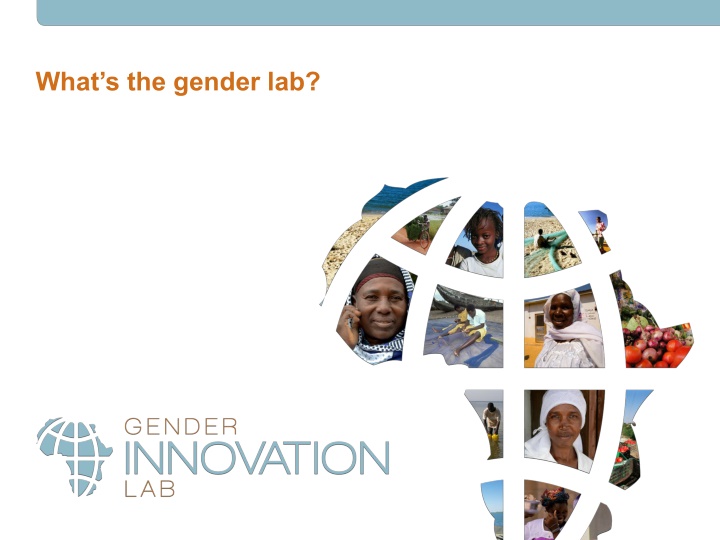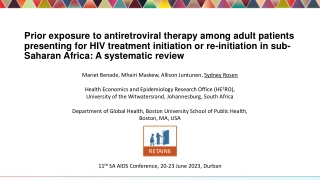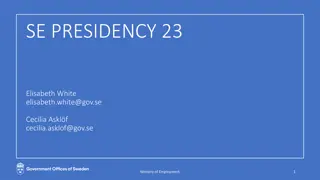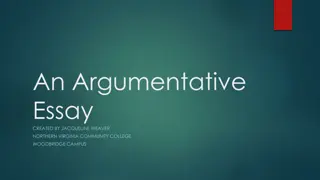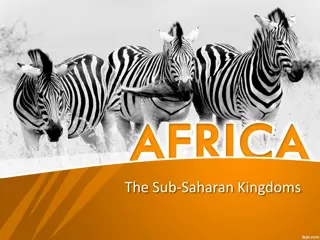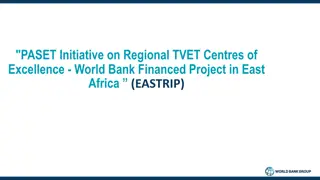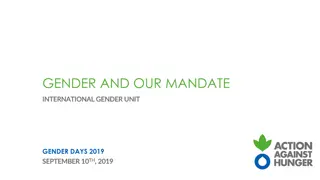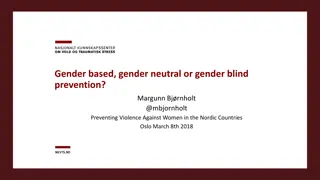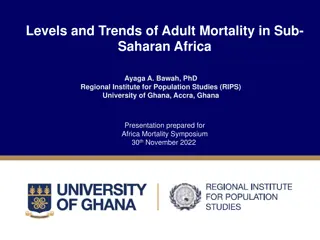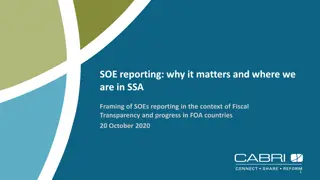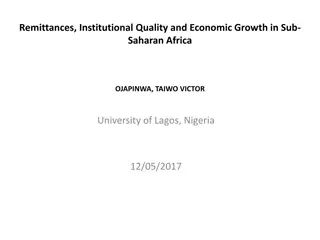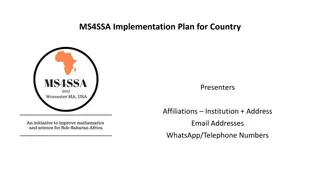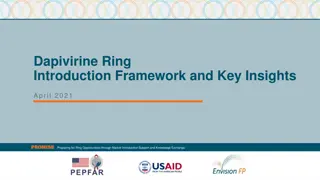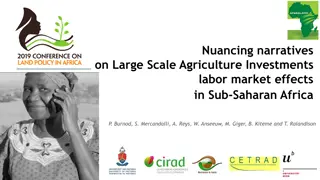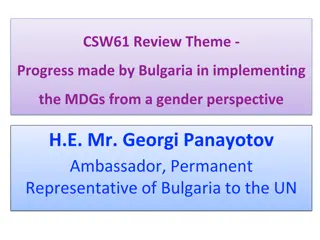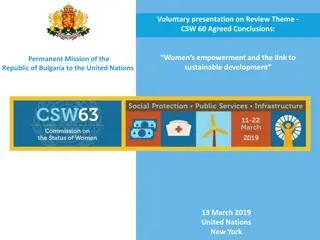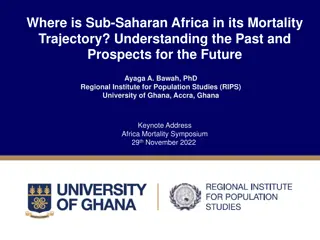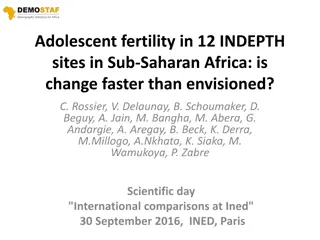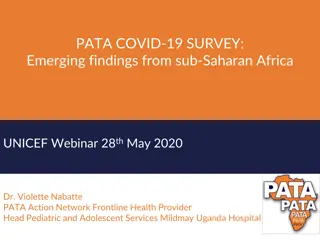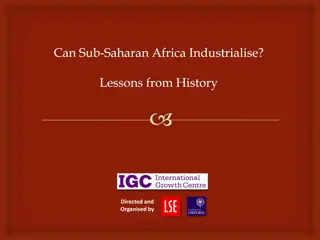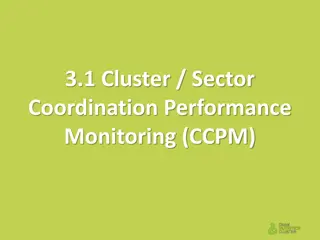Gender Equality Initiatives in Sub-Saharan Africa
More than 50 active projects in 25 countries are focused on improving gender equality in various economic sectors such as agriculture, property rights, youth employment, enterprises, and combating violence against women. The approach involves a core analytical team leading evaluation activities in collaboration with outside academics and operational teams. Evolution from opportunistic work to strategic key questions in thematic areas has led to innovative interventions and increased project demand. Emphasis is on understanding constraints like occupational segregation to pilot interventions and increase female participation in non-traditional trades.
Download Presentation

Please find below an Image/Link to download the presentation.
The content on the website is provided AS IS for your information and personal use only. It may not be sold, licensed, or shared on other websites without obtaining consent from the author.If you encounter any issues during the download, it is possible that the publisher has removed the file from their server.
You are allowed to download the files provided on this website for personal or commercial use, subject to the condition that they are used lawfully. All files are the property of their respective owners.
The content on the website is provided AS IS for your information and personal use only. It may not be sold, licensed, or shared on other websites without obtaining consent from the author.
E N D
Presentation Transcript
Figure out what works and what does not to improve gender equality and use it to shape policy
Status and structure More than 50 active projects in 25 countries in sub-Saharan Africa Five thematic areas centered around economic activity: agriculture, property rights, youth employment, enterprises, violence against women (small) Structure Core analytical team (leads the evaluation activities) Partnerships with outside academics but as equals Active partnerships with operational/implementation teams on both the design of impact evaluations and the use of the results They help shape the set of questions to ask (design) They are more respected by their operational peers in sharing the results (use)
Evolution v. 1.0 Work opportunistically, fair amount of convincing needed v. 2.0 Organize around thematic areas More demand for our help (e.g. call for projects, increasing number of people calling us for help on both ops & impact evaluations) More scope to innovate within projects try new and out of the box interventions V 3.0 Organized around a set of key questions identified in white papers (what do we know, what do we need to know) within thematic areas Even more involvement in design (and implementation) Strategic approach to getting results used (prioritization, new modalities)
How we get projects Two ways 1. Call for projects interested in getting an impact evaluation We will do an impact evaluation of your intervention Work with anyone WB projects, but also governments direct, firms, NGOs Top-up money (small) available for innovations (e.g. bringing in a specific kind of technical support to try something new) 2. Opportunistically Early on: active seeking out of projects and convincing them Now: we have more of a reputation and people come to us (3 types validators, innovators, and looking for innovations)
1. Understanding the underlying constraints Example: occupational segregation Big part of gender earnings gaps come from differences in sector/occupational choice Two studies Uganda and Ethiopia to understand who are the women who break through to male dominated trades When they do, they make the same Mentorship, information key Results lead to pilot interventions in the Republic of Congo, Guinea. Under discussion in Kenya and Turkey. Working with partners to increase female participation in non-traditional trades e.g. tech sector, heavy machinery
2. Synthesis Example: Leveling the Field & Costing the Gender Gap Leveling the Field (joint with ONE & LSMS-ISA): looked at the gap in productivity between male and female farmers and the main factors contributing to the gap in 6 countries The cost of the gender gap in agriculture (joint with UN Women, UNEP, UNDP): looked at how much the gap meant in terms of GDP, poverty reduction in 3 countries. High international visibility WEF (Africa), CADP, press, etc. National events for dialogue (e.g. Malawi, Uganda) Refocus the discussion on the constraints to female producers, and raise the issue of labor (next generation work now being developed with agriculture team)
3. Innovation Example: Business training that really works 2014: Review of rigorous evidence: no evidence that business training programs really move profits Is it the wrong skills? Wrong people? Or do skills not matter? Innovation: business training that draws on psychology and focuses on mindset (e.g. how to be proactive) than practices (e.g. how to keep accounts). Evaluation: Togo compared a standard (World Bank designed) business training vs. Personal Initiative Training Results: for women PI training = 40% higher profits. Taking the results to other places: Mexico, Jamaica, Ethiopia, Mauritania, Mozambique (farmers). And within the World Bank, some re-thinking on what we offer.
4. Advising specific programs Example: Land registration in Rwanda Rigorous evaluation of a pilot version of the program showed: Big increases in investment, 10% for men, 18% for women Increase in women s ownership rights within households.. But women who were not formally married (~30%) were losing rights Pilot results shared with government. Program goes national with changes to operating rules. Now all women are benefiting equally. On demand project support ranging from a one-off briefing to full participation in project design and implementer connections
5. Informing national policy dialogues Example: Nigeria National 4 city dialogue, with workshops to identify actionable priorities Priorities fed back to the Ministry of Finance Also opened up space for different interventions with the World Bank country team projects Leveling the Field work lead to agricultural policy gender dialogue in Abuja chaired by Ministers of Finance and Agriculture Ultimate outcome was a first generation agro-processing experiment with the Ministry of Agriculture Also worked with GWIN former government s flagship program on extra funds for ministries that execute additional activities on gender
6. Taking what works to scale Example: programs for adolescent girls Multiple impact evaluations complete and underway to look at the impacts of adolescent girls programs in multiple dimensions. Liberia 47% increase in employment among trainees 80% increase in average weekly income Significant increase in frequency and amount of young women s savings Uganda Increase in girls earnings and spending on themselves 26% less likely to have a child Sex against their will drops by 76% Results go to scale: to date over $200m in operations, reaching 100,000 girls in 8 countries, including India
Recap: Ways the Lab works Understanding the underlying constraints Synthesis Innovation Informing national policy dialogues Taking what works to scale
The overall approach Rigorous evidence More than inform policy: research uptake = scaling up what works and scaling back or changing what does not Concrete policy advice to support moving from advocacy to action Partnerships government agencies, operations teams within the World Bank, NGO staff, donor staff in other agencies (e.g. USAID, MCC), private companies, and academics (global) Leverage: relatively small investment in building knowledge pays off in policy and project changes in Africa GIL so far $1 directly shifts $46 in development spending plus: policy changes, more $ for projects, scaling down ineffective projects, innovation with firms
More on the web: http://www.worldbank.org/en/programs/africa- gender-innovation-lab
